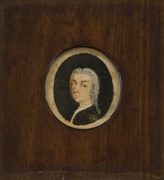Johann Adolph Scheibe (1706–1776) – A descriptive catalogue of his works
Peter Hauge
Thursday, November 30, 2017

The following has reached us from Peter Hauge (Royal Danish Library):
For the first time ever a detailed descriptive catalogue of Johann Adolph Scheibe’s works has been published as a database. Scheibe was very productive, not only as a composer – ranging from large-scale cantatas and oratorios to sinfonias, chamber music and communal songs – but also as a translator of literary works as well as academic studies, in addition to being an author himself. Though he was only Court Kapellmeister in Copenhagen for a brief period, he remained in Denmark until he died in 1776. Scheibe participated in discussions among the intellectuals in Copenhagen, including Schlegel, Klopstock, Gerstenberg, Basedow, Hagedorn, Münter and Cramer, and he maintained a correspondence with Telemann, Gottsched, and C.P.E. Bach, to mention a few.
Although, according to his autobiography in Mattheson’s Grundlage einer Ehrenpforte (1740), Scheibe had composed more than 400 works by 1739, a catalogue presenting the works that have survived in today’s archives and libraries worldwide would only reveal a meagre result. A hasty conclusion might be that musical activities in Copenhagen during the eighteenth century were nearly non-existent; however, focusing merely on the surviving musical material presents a somewhat distorted picture. It is important to keep in mind that the largest collection of music, the royal collection, was engulfed in flames in 1794 when Christiansborg Palace burnt to the ground. In addition, when Scheibe died many of his private manuscripts were sold, some of them ending up in the Royal Danish Library shortly afterwards; the majority, however, were most likely bought by private connoisseurs whenever a sale was advertised in the newspapers. Even the later Kapellmeister Claus Nielsen Schall (1757–1835) and C. F. E. Weyse (1774–1842), who was court composer, obtained works in manuscript. Weyse sold some of them on to the music collector Georg Poelchau (1773–1836) in Berlin, while keeping others for himself.
The point of departure for the catalogue (which is cited in the RISM online catalogue using the abbreviation SchW), is different from traditional ones in that it seeks to include those musical works which apparently have not survived but for which there is clear evidence of having existed, for example as represented by the large number of printed librettos. The database provides not only new information on Scheibe, the composer, translator and educator, but also sheds new light on musical life in Denmark and in particular Copenhagen during the eighteenth century.
Image: Portrait of Scheibe (photographer Rolf H. Christensen). The portrait belongs to Sorø Akademi.
Share Tweet EmailCategory: Electronic resources

